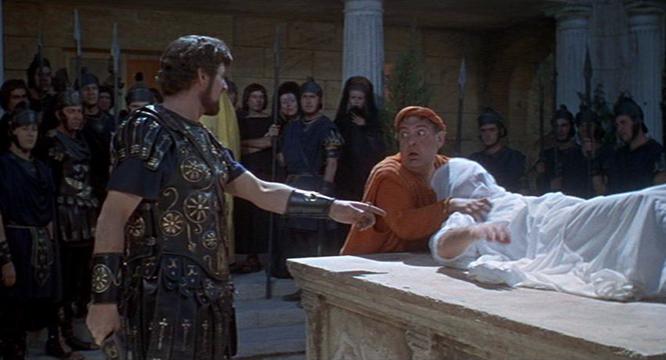Titus Andronicus is regarded as Shakespeare’s bloodiest play, and Julie Taymor’s adaptation doesn’t shy away from that legacy. Rape, murder, cannibalism, and dismemberment are all included in this at times hard to watch adaptation. Taymor takes a postmodern approach, and it’s apparent from the stylistic meshing of eras and music that, to Taymor, the past century has been chaotic indeed. Intentionally fascist imagery dominates the screen, creating a look akin to Mussolini’s Rome, and every frame of film is packed to the brim with visual allusion. This begs the question, why did Julie Taymor choose to adapt Titus Andronicus in such a way?
In the Roman world, such a punishment as dismemberment was far from uncommon. There was simply no concept of cruel and unusual punishment. The Emperor Aurelian had a favored method of execution according to the Scriptores Historiae Augustae that saw the condemned tied to two trees. The trees were then bent to the ground and secured with rope. When the ropes were cut, the trees would spring upward and tear the condemned into pieces (Sabin, Philip; van Wees, Hans; Whitby, Michael (2007). The Cambridge History of Greek and Roman Warfare: Volume 2, Rome from the Late Republic to the Late Empire.).

In modern times, such a punishment is unheard of. Even our harshest offenders are not always deemed worthy of execution. At some point, this level of violence shifted from a punitive measure to the crime itself. Taymor’s Titus brings this barbarism back into modernity. We watch the characters discuss and commit their heinous acts amidst the bright neon lights of arcade games and in cars on well-paved streets. They wear modern clothes as they rape and mutilate; their hands are chopped off in gleaming silver kitchens. This blend of time is not by mistake. Taymor is making a statement by introducing the glitz and glam of modernity into the grim violence of a stylized Ancient Rome.
Critic Philip French says of Titus, “People may suffer, but they are not ennobled by their experience. The incessant cruelty, the sense that nothing turns out the way people of goodwill expect, is part of the experience of this past century. The abrupt switches of mood, the shafts of black humour, the pick ‘n’ mix of fashions and styles (in music, setting, decor), the sex ‘n’ violence, are characteristic of the art of our own time.” (French, P. Film of the week: Titus. The Guardian.)
We delude ourselves if we say such violence no longer exists. It simply happens where we can’t see. Taymor uses postmodern film-making to show us this. By bringing antiquated material into the near-present, Taymor brings with it the violence. The horrors of the past, which we so often think exist only in the past, exist around us everyday. The vilification of rape survivors, suffering as entertainment, the almost casual brutality displayed in the film: Taymor is reminding us that those things have not disappeared. Neither should our reaction to them. Horrifying actions deserve a horrified response.
Titus benefits from phenomenal performances out of its cast. The characters, in all their exaggerated glory, are made believable thanks to strong directing and acting. It is easy to get distracted in the sometimes messy visuals, or get lost in the twisting story, but Titus is a prime example of what postmodern cinema is capable of.
French, P. (2000, September 3). Film of the week: Titus. The Guardian. Retrieved November 1, 2021, from https://www.theguardian.com/theobserver/2000/sep/03/features.review27.
Womack, J. (2017, June 26). Ancient roman punishment was swift, cruel and unusual. Wyoming County Report. Retrieved November 1, 2021, from https://www.wycoreport.com/ancient-roman-punishment-was-swift-cruel-and-unusual/article_a2046211-e8b5-518a-9fe7-8a65cf30014c.html.
Sabin, Philip; van Wees, Hans; Whitby, Michael (2007). The Cambridge History of Greek and Roman Warfare: Volume 2, Rome from the Late Republic to the Late Empire. Cambridge: Cambridge University Press. p. 439
Titus . (1999).

I think that the concept of post modernism incorporated by Julie Taymor made Titus a very distinct film in terms of story telling about ancient Rome . It was also among the first female directed films that we have covered so far in the semester. Julie Taymor managed to combine elements into the film that are uncommon for the sword and sandal genre. The dialogue, the characters, the time eras and the setting are few among the elements she utilized. I think the beauty of post-modernism is how everything seems unconnected but yet connected at the same time which makes the plot of the film very interesting just like in Titus
Although Titus was a box office flop, I completely agree with you that it is a good representation of post modernism cinema.
I think this blog post is very well done and you show how postmodernism is used as a particularly well crafted story telling device. How you highlight the the ways in which violence is used in the film and make the statement that to believe such violence dosent exist is a delusion in of itself. I think that plays directly into how a female director impacts this film in such a profound way making this a very well done post.